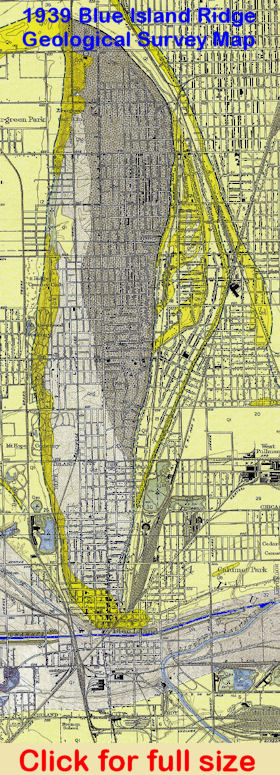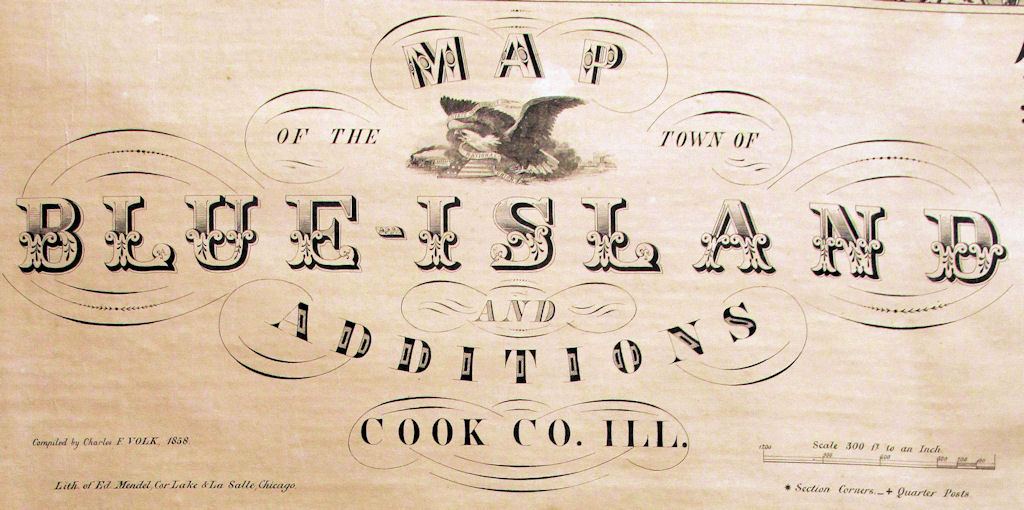

Is situated partly on the Southern extremity of a high ridge covered mostly with lumber and partly on the adjacent prairie. It is sixteen miles from Chicago, on the Chicago and Rock Island Rail Road. It has water communication with Lake Michigan by means of the Calumet River and also with Chicago by a branch canal. It is seven miles distant from the Lake and nine from the main Canal. Contiguous to the River and Canal are extensive brick-yards and stone quarries, which contain building materials of the finest quality. There is an excellent water Power affording good opportunities for mills and manufacturies. The place numbers at presentabout Two Thousand inhabitants. It has four breweries is operation and several others are contemplated the location affording peculiar advantages for cellars. Also six stores two lumber yards one Church and a fine Public School House. The place is remarkably healthy and situated as it is, so near the Empire City of the West, it holds out many inducements to those who are seeking for a pleasant location for homes.
• Charles F. Volk - 1858
The Ridge rising out of the prairie south of Chicago took on a bluish haze during the springtime and gave both the Ridge and our town their name - Blue Island. Heber S. Rexford, brother of Norman Rexford, came to Chicago in 1832 and took up a claim in the "Yankee Settlement" of Cooper's Grove (now Oak Forest). In his reminiscences published in the Blue Island Standard in 1876 related the following:
"The north end of the bench of land on which Blue Island stands was originally covered with a dense forest, and from Chicago, before the view was obstructed by buildings, this timber presented a blue appearance like smoke. Water was like-mirrored forth by the mirage which almost always prevailed, giving the timber the appearance of land surrounded by water, and it was from this circumstance that the hunters called it Blue Island."
During the summer of 1834 Tom Courtney arrived on The Blue Island Ridge with wife and daughter . He had moved west with the desire to build a home in the Illinois forest. He found the south end of the Ridge ideal and cleared a spot to build a cabin where the First Lutheran Church would eventually be built at the corner of Grove and Ann Street. History is vague on the life of the Courtneys, but it says that his wife got sick, suffered severely and died in 1835. Unable to help or get help for her caused Tom to become slightly deranged watching her suffer. Time and an incresed population healed things somewhat, just as they camouflaged what became of Blue Island's first white settler.
Early arrivers to Blue Island chose the southern end of the Ridge overlooking Stony Creek as the best site to begin their settlement and in 1836 the first inn opened there providing travelers a place to rest along the Vincennes Trail that ran between Fort Vincennes in Indiana and Fort Dearborn in Chicago.
Blue Island's second white settler and first permanent resident, Norman Rexford (June 4, 1802 - March 25, 1883) arrived in 1835, settled in and established the "Blue Island House" at the southern edge of the ridge - 1000 feet from the Courtney Cabin - in November 1836 and in 1838 he became the settlement's first postmaster.
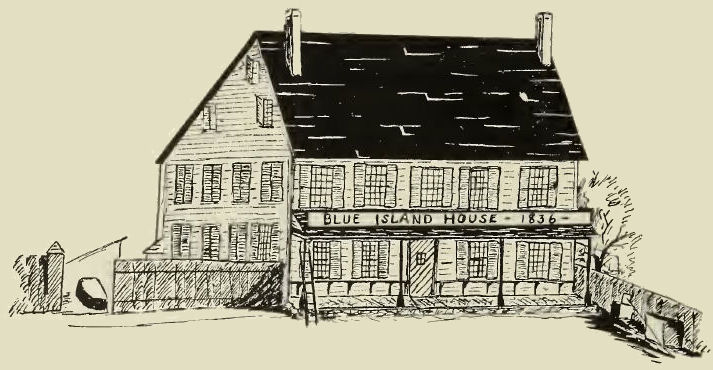
The 'Blue Island House was the first structure of a permanent character to be erected in Blue Island. It was built by Norman Rexford in 1836 and for many years served as a hotel and as a home for the Rexford family. The picture printed here is from a drawing reproduced from a pencil sketch which was made during the early years when th building was still standing. The original sketch is yellowed with age and is a prized possession of the Rexford family. The artist has faithfully copied all the crudities of the original drawing. The sketch was kindly loaned by Fred K. Rexford of Pasadena, Cal.'
• The First Hundred Years 1835 - 1935 ~ John H. Volp 1935

'As traffic between the two forts increased, so did business at the inn. It was a popular place and became well-known for the social gatherings held there. The Blue Island House stood on the east side of what is now Western Avenue (then the Wabash Road) about halfway between the present Grove and Fulton streets. The ridge at that time was much steeper and more abrupt than it is now which allowed Mr. Rexford to hang beacon lights in the upper windows to invite weary travelers. Rexford sold the inn in 1852, but it's popularity continued until it was destroyed by fire in 1858.'
• First Hundred Years by John Volp
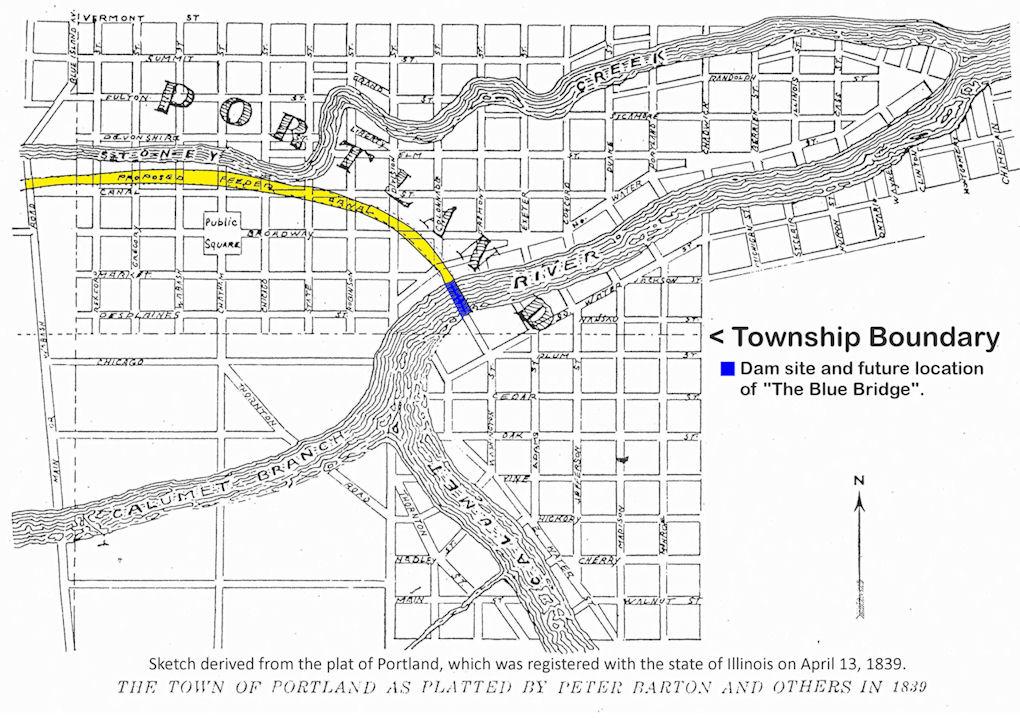
In April of 1839, Peter Barton and his partners registered the plat of "Portland" with the state of Illinois with the hope of developing a prosperous river town along the Little Calumet River. After purchasing land south of where Vermont Street is and east of Wabash (now Western) from the federal government, Barton laid out "Portland" and included a public square location and the planned feeder canal that was yet to be built. About half of the original area was eventually incorporated into Blue Island while the rest became part of Calumet Park, Calumet Grove (now the Joe Louis Golf Course, and unincorporated areas of Calumet Township. Most streets were never built and some don't bear the names of those proposed, but most of the ones built still exist.
According to John Volp, whose family had lived in Blue Island since 1862: "'Portland' did not become a river town. Neither did the name 'Portland' ever come into general use. In spite of all the efforts of its promoters to popularize the locality the people preferred to live on top of the hill and call the place 'Blue Island'...".
In 1843 as development grew on top of the Ridge, the Illinois State Legislature enacted: "An Act entitled AN ACT TO CHANGE THE NAME OF PORTLAND IN COOK COUNTY TO THE NAME OF BLUE ISLAND: Be it enacted by the People of the State of Illinois, represented in the General Assembly that the name of the place called Portland in Cook County, Illinois is hereby altered and changed to Blue Island and the same shall hereafter always be known and called by such name of Blue Island. Approved February 24, 1843."
When first built, the Illinois and Michigan Canal provided America's only water link from the east coast to the Gulf of Mexico. Since the Calumet River flowed into Lake Michigan from it's source in Indiana, it was decided to build a dam across the Calumet River and a feeder canal in Blue Island to supplement water flow through the I&M Canal.
The first water from the Calumet River was turned into the feeder June 12, 1849, and on July 22 of that year the first canal boat arrived at Blue Island. Merchandise traffic on this canal continued nearly twenty years. The dam caused flooding to farmers fields upstream of the dam in Indiana and for years caused animosity and numerous lawsuits until March of 1874 when the Illinois legislature passed "An Act to authorize the removal of the feeder dam across the Calumet River near Blue Island in the County of Cook, State of Illinois, and to provide compensation to Christian Pfeiffer and John Roll for any loss that they may sustain by its removal."
Section 2 of this Act provides: "That so soon as Christian Pfeiffer and John Roll shall release to the State of Illinois by quit claim deed all right they now claim to have to the said dam and the water power thereby created, that then and in that case on the order of the Governor, the Auditor of Public Accounts be, and he is hereby authorized to draw his warrant on the State Treasurer in favor of said Christian Pfeiffer and John Roll for the sum of not exceeding six thousand dollars ($6,000.00) to be paid out of any money at any time in the treasury not otherwise appropriated." On April 9, 1874, John L. Beveridge, then governor, notified the state treasurer that Pfeiffer and Roll had complied with the requirements of Section 2 of the Act and directed that they be paid $6,000.00, also; "that by virtue of said act you are hereby authorized and directed, without delay, to remove the dam the expense of said removel to be paid out of canal funds in your hands."
For some reason or other the dam was not at once removed. Roll continued to use the water power from the spillway of the dam for his grist mill and to all appearances there was no hurry about removing the obstruction in the river. The Calumet Feeder and 90-foot reserve on either side thereof, together with the overflowed lands along each side of the Calumet River came into possession of the State of Illinois at the completion of the dam at Portland in 1848.
In 1848 steamer ships from the Mississippi were sailing to Chicago via the Illinois and Michigan Canal and passenger and mercantile shipping along the Blue Island Feeder Canal flourished for years. But in the early 1870's other means were formed to supply water to the Illinois and Michigan canal and the Calumet Feeder Canal was abandoned by the Canal Commissioners. By then river traffic had been on the decline as the railroad completed construction through the area and took over the transportation of goods and people. In 1875, farmers whose land was being flooded became incensed at the delay of the dams removal and one night a group of 50 or more took matters into their own hands and blew up the hated dam.
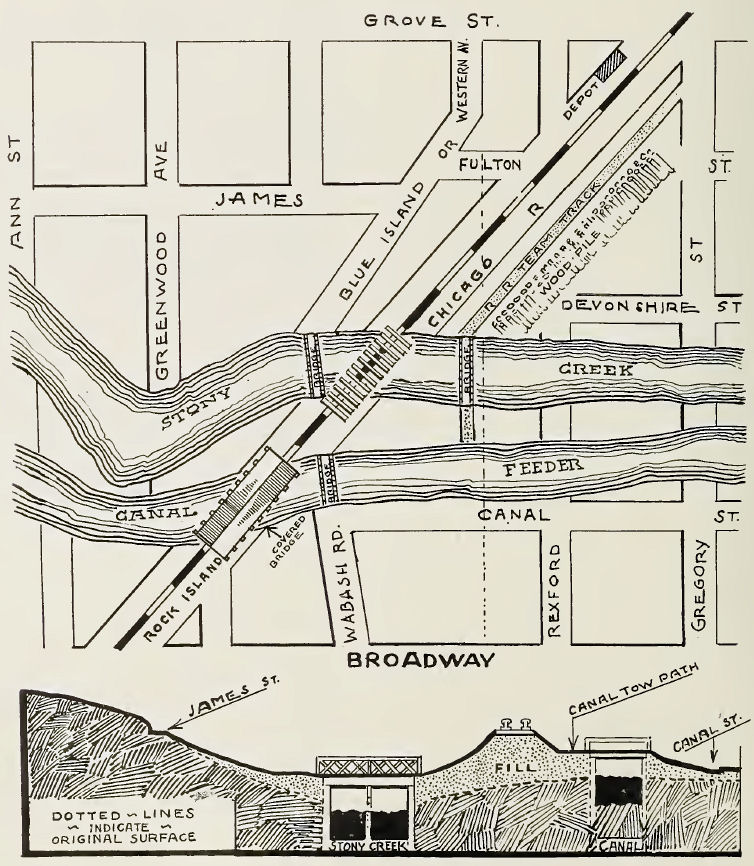
• Reference: John Volp's First Hundred Years 1835 - 1935
Meanwhile back on top of the Ridge, the 'Yankees' (defined as: transplanted English) had established the village of Blue Island as an agricultural market center. German agricultural laborers began arriving in the 1850s, and by the 1890s they had usurped political and economic power from the 'Yankees'.
Small-scale factories, brickyards, breweries, shops and other businesses were flourishing across the area. Production from two brickyards in Blue Island to grew and by the 1890's, six brickyards in Cook County were producing over 2 billion bricks a year.
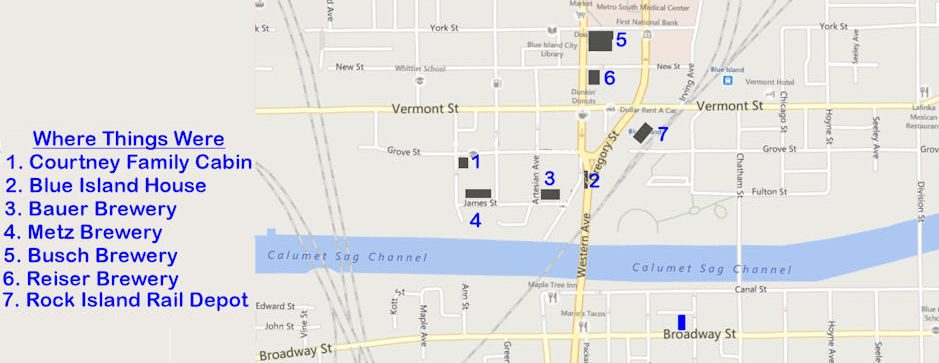
Until the Eighteenth Amendment put them out of business in 1919, Blue Island was home to four breweries who used the side of the hill to store their product before the advent of refrigeration. In the early 1850's Henry Bauer opened the first brewery in Blue Island just below the south end of the Ridge at Henry (now Artesian) and James Streets. A relatively small company, whose product was highly regarded, the Bauer Brewery remained in business for many years.
Originally known as the Busch & Brand Brewery, the Blue Island Brewery (United Breweries Company) got it's start in 1853 when Valentin Busch and Michael Brand established a brewery in Blue Island. They already had a plant on Cedar street in Chicago, but Blue Island's hilly land made it possible for them to build underground cellars. For twenty years the firm operated breweries in both cities, but, in 1874, the Blue Island brewery was sold to Mr. Rudolf Brand, who operated it for several years until 1896 when the Blue Island Brewing Company was incorporated. The business became a part of the United Breweries Company of Chicago in August, 1898. As underground cellarage was then considereded to be an absolute necessity to the brewer, the first consideration in the choice of location was the nature of the ground. For this reason the pioneer brew-houses of Cook County were situated in Blue Island and Riverside, which was also high ground. Shortly before Chicago's Great Fire of 1871, the partnership was dissolved, the Blue Island plant being taken by Mr. Busch, who died in 1872, while Mr. Brand operated the Chicago Brewery. Michael Brand's nephew Rudolf purchased the Blue Island plant in 1874, and operated it until 1878, when he sold the brewery.
Old Breweries.com lists four breweries in Blue Island in the late 1800's:
• John Bauer
• Busch & Brand
• G.H. Hausberg / Reiser
• Metz & Schwachow
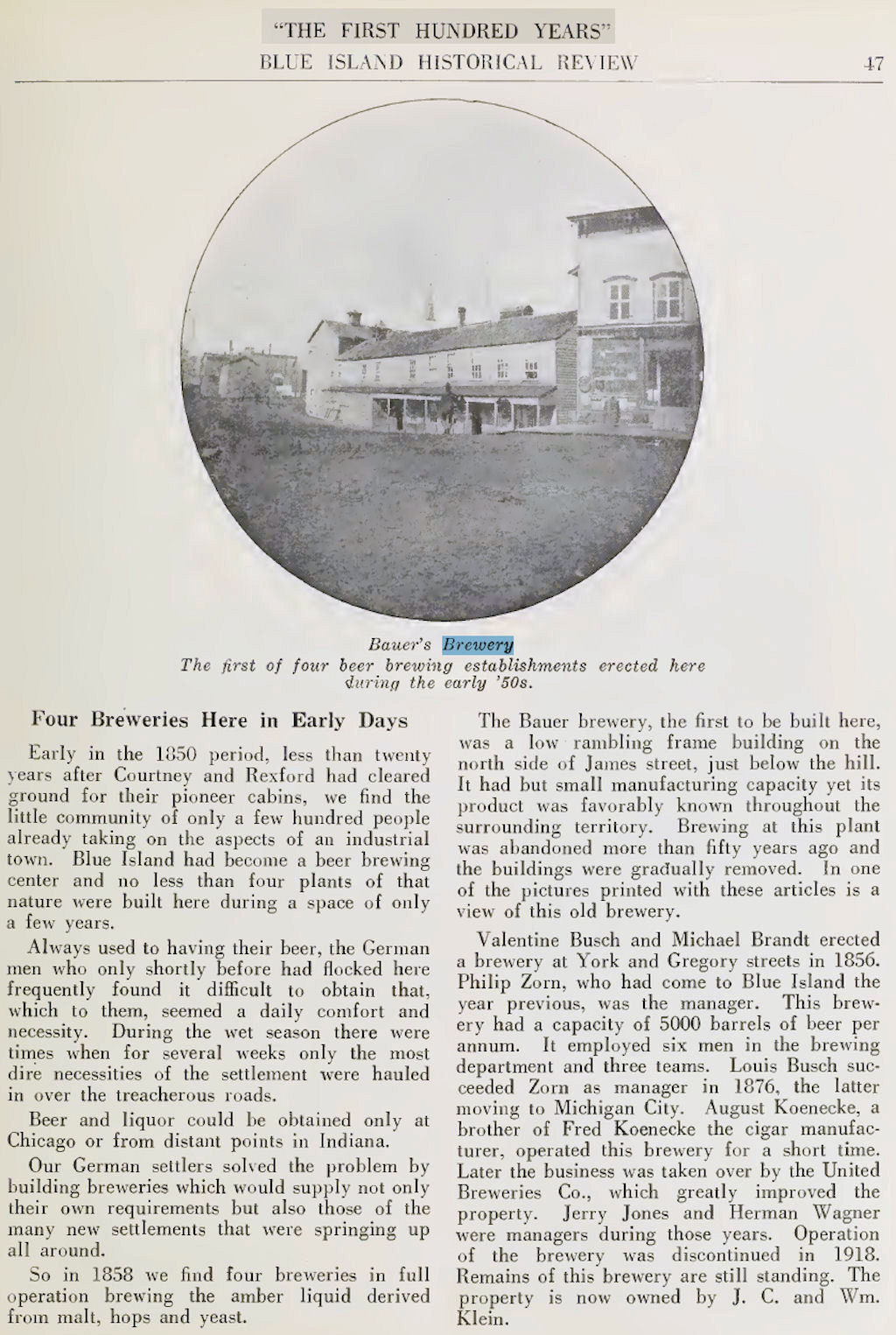
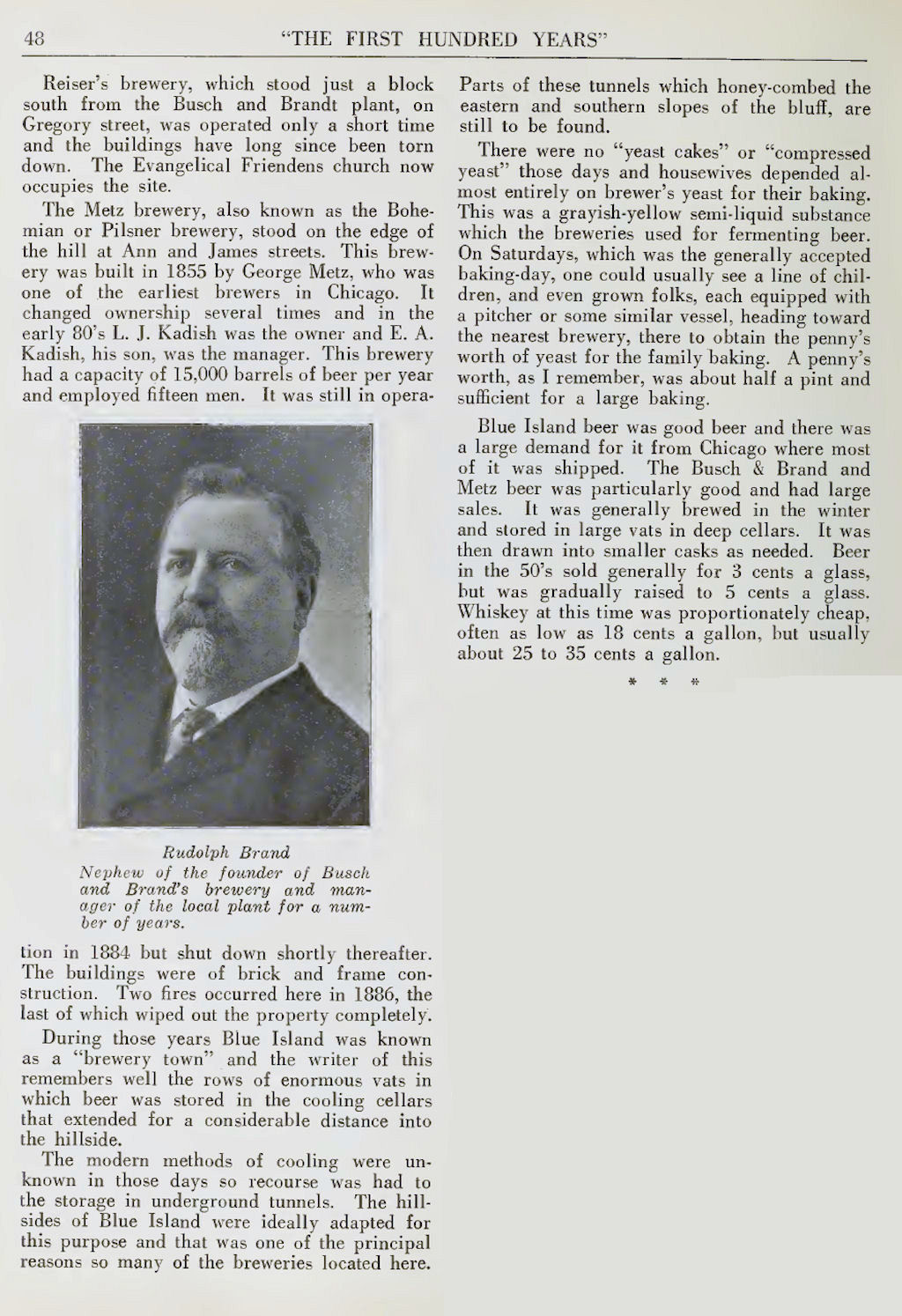
In 1872 Blue Island incorporated as a village using Division street on the east to California avenue on the vest; the Thornton-Bremen township line (135th street) on the south to 119th street on the north which made Blue Island rectangular shaped about one mile wide and two miles long.
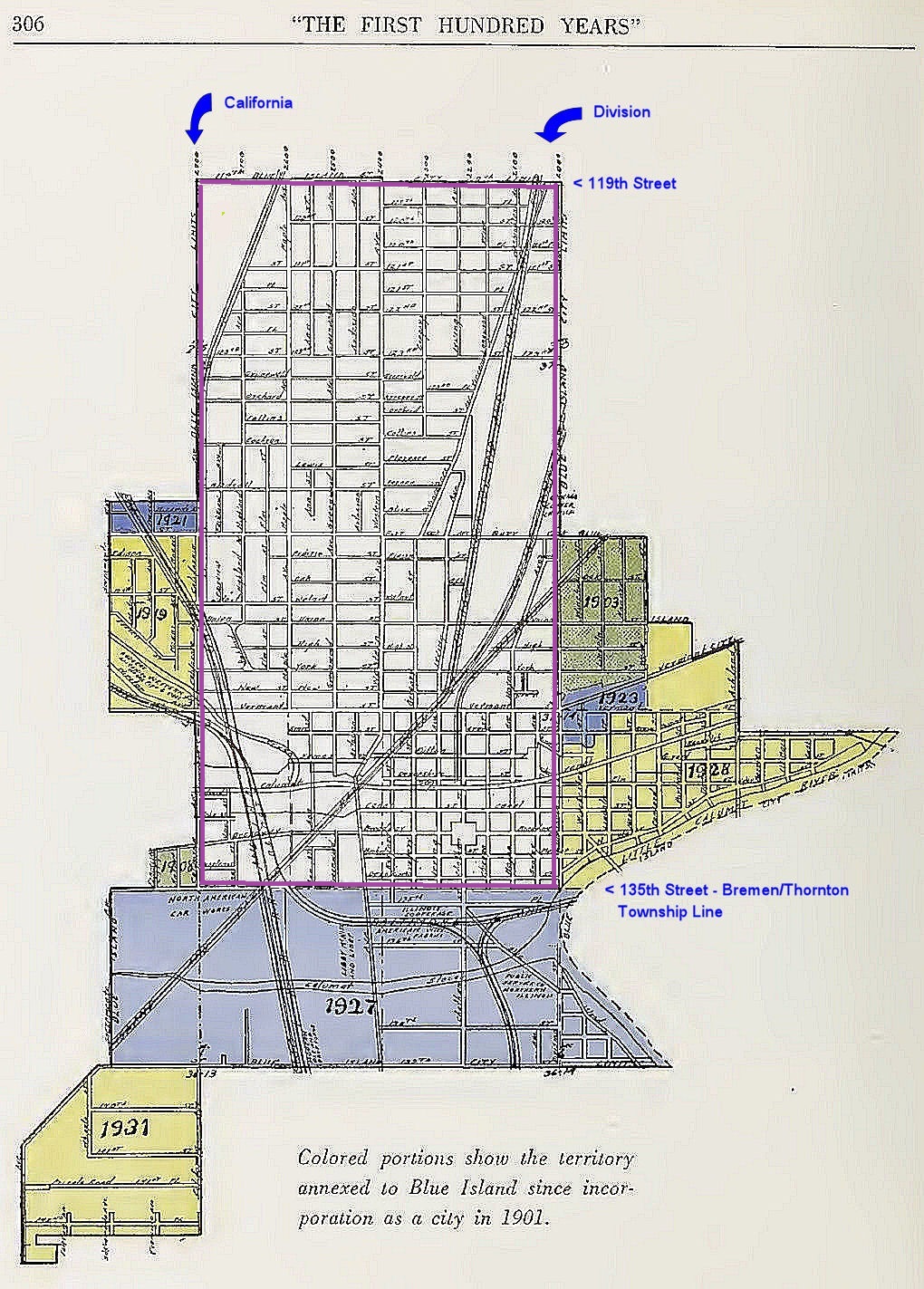
Those boundaries were still in place when Blue Island was incorporated as a city in 1901. Annexation electios held in 1903, 1908, 1919, 1921, 1923, 1927, 1928 and 1931 almost doubled the size of the city. In addition to new areas that were added to the city, the annexations restored most of the areas that had been omitted from the Village boundaries. The largest and most valuable parcel annexed was voted on in 1927 and included the area south of 135th Street to 139th Street from the Calumet River to Sacremento Avenue.
Blue Island voters defeated a proposition in 1915 when 894 people voted for and 2965 voted against the annexation of Blue Island by the City of Chicago.
Throughout this period of growth, one of Blue Island's biggest problems was fire. Be it a prairie fire racing across the grassy fields, or a fast burning wood frame building, Blue Island's Volunteer Fire Department fought and prevented conflagrations on a regular basis. In the day's before any type of alarm system existed, the shout of "Fire!" would be repeated over and over to alert everyone and to organize an appropriate response to the menace confronting them. At night, someone would run to John Huppel's house and arouse the Tinsmith. He would hang a drum around his neck and parade up and down Western Avenue, often in slippers and nightshirt, beating his drum to arouse the sleeping citizens.
The early settled area on the south end of The Ridge seemed to bear the brunt of the fires:
• Schapper's Drugstore was destroyed by fire in 1856.
• The Blue Island House burned in 1858.
• In the 1850's the German Theater located on the north side of Vermont Street where the Central M.E. Church would eventually be built.
• Dillschneider Building at Western & Fulton burned in the late 1850's.
• Around 1860, the Robinson Building on Grove just west of Henry (now Artesian) Street while being used as a paint shop.
• Around the same time, the Massey-Sammons Warehouse was also consumed by fire.
• In the early 1860's, Chuck Volk's Chicory Factory in the old Reiser Brewery building at Gregory & New caught fire.
The cry of "fire! fire!" at any time a dreaded sound, was doubly so in the days of the 50's when the equipment and methods of combating the red demon were of the most crude and inadequate sort. Yet the little bands of volunteer fire-fighters did valiant service, and, although the building that was on fire usually burned to the ground, they often succeeded in preventing the flames from spreading to adjoining property.
It was a real honor and distinction those days to belong to the "fire department," and nearly every prominent and able-bodied man did "belong". The fire department was the leading civic organization of those days. It usually arranged the picnics, dances and other public events. July 4th was the big day. This holiday seemed to have been made especially for the volunteer firemen and on this day the "department" was out in full force and in its greatest splendor.
• The First Hundred Years 1835 - 1935 ~ John H. Volp 1935
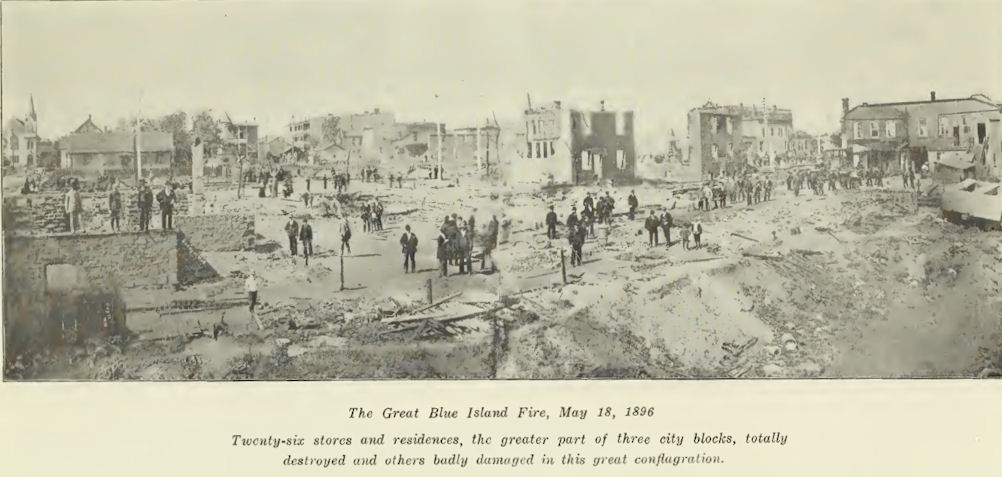
The Great Blue Island Fire of 1896
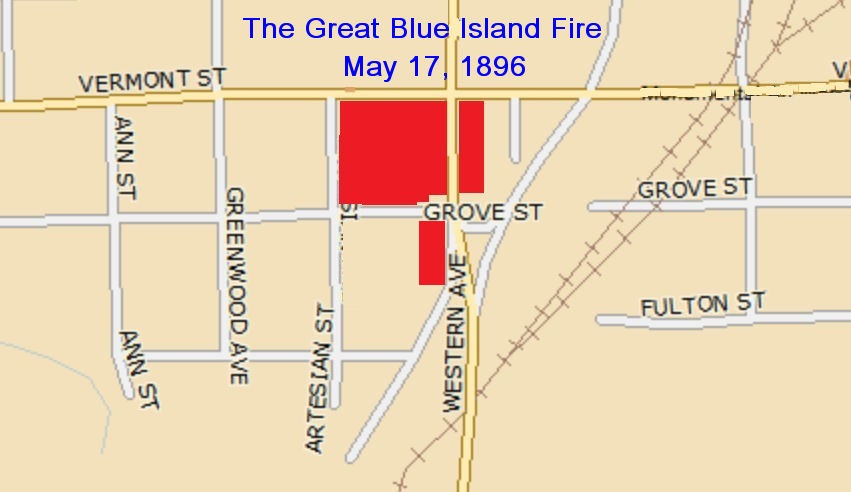
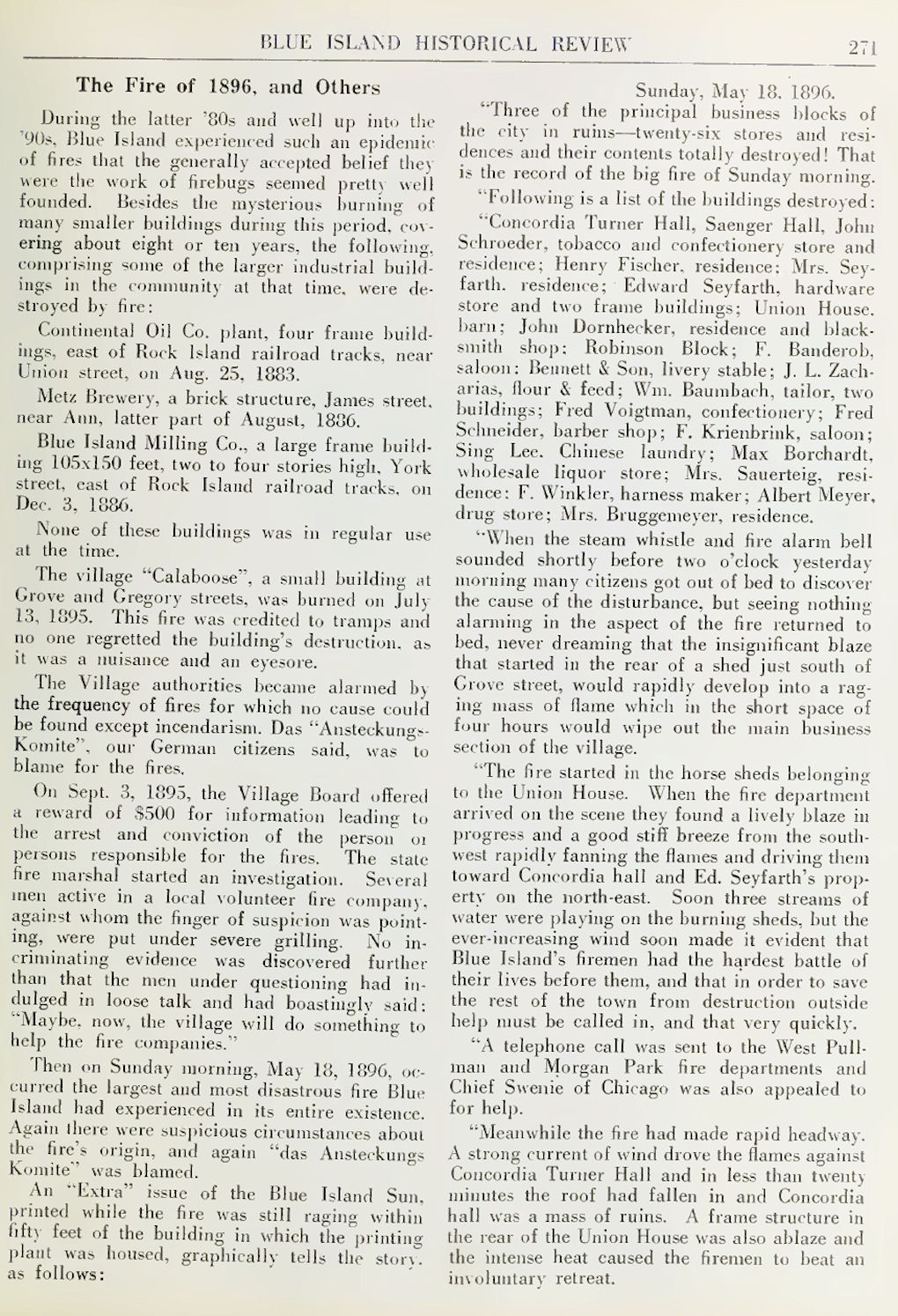
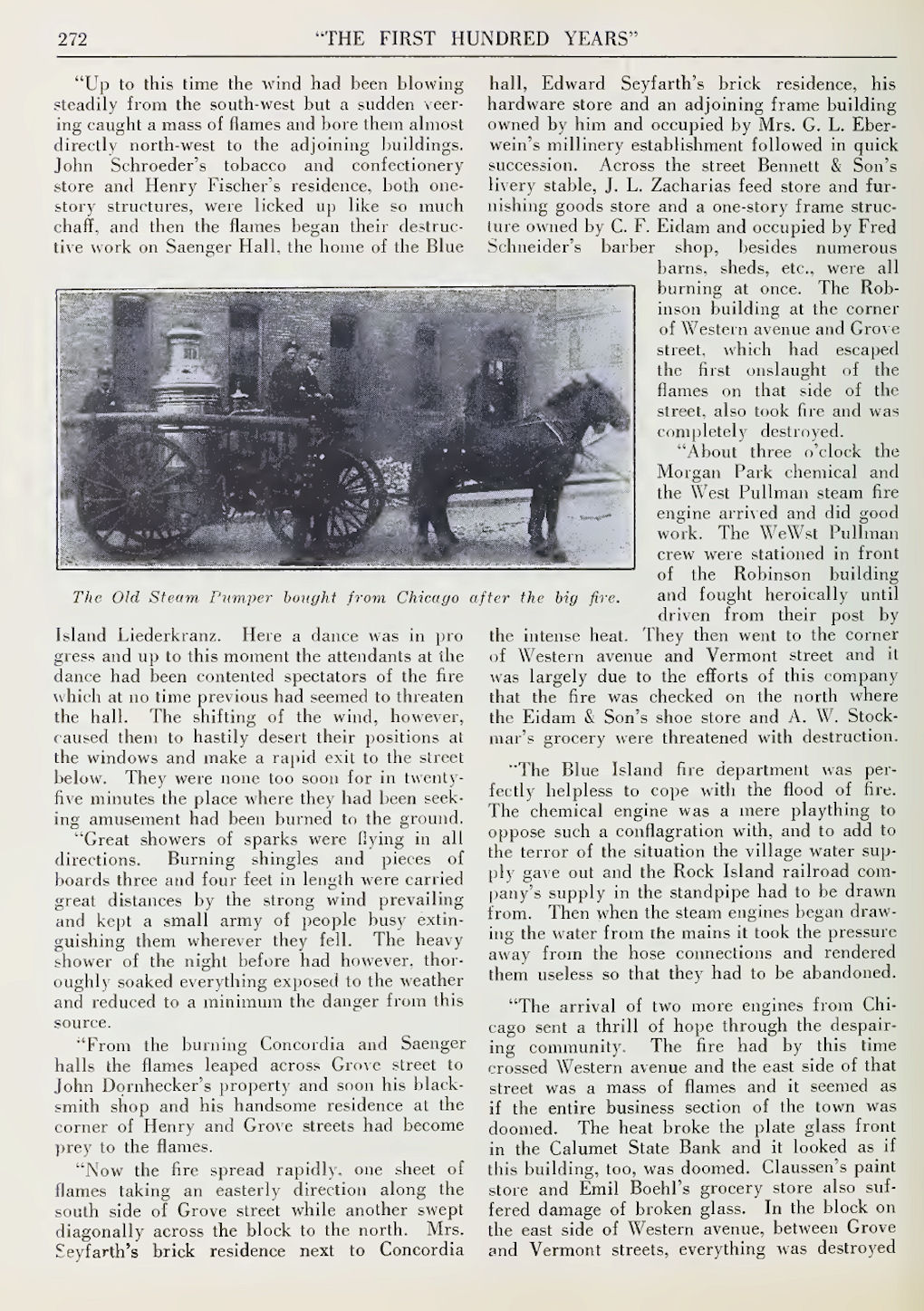
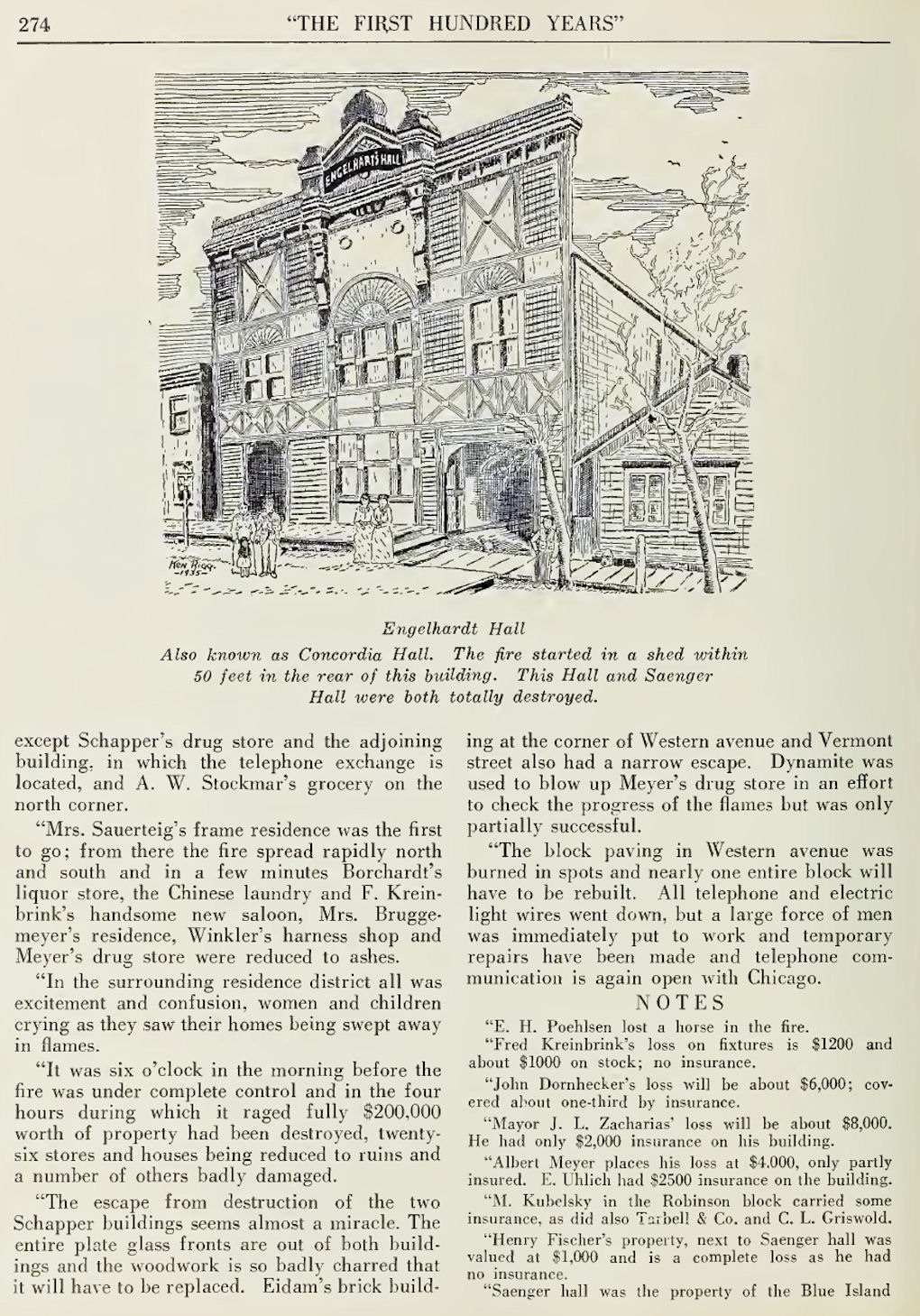
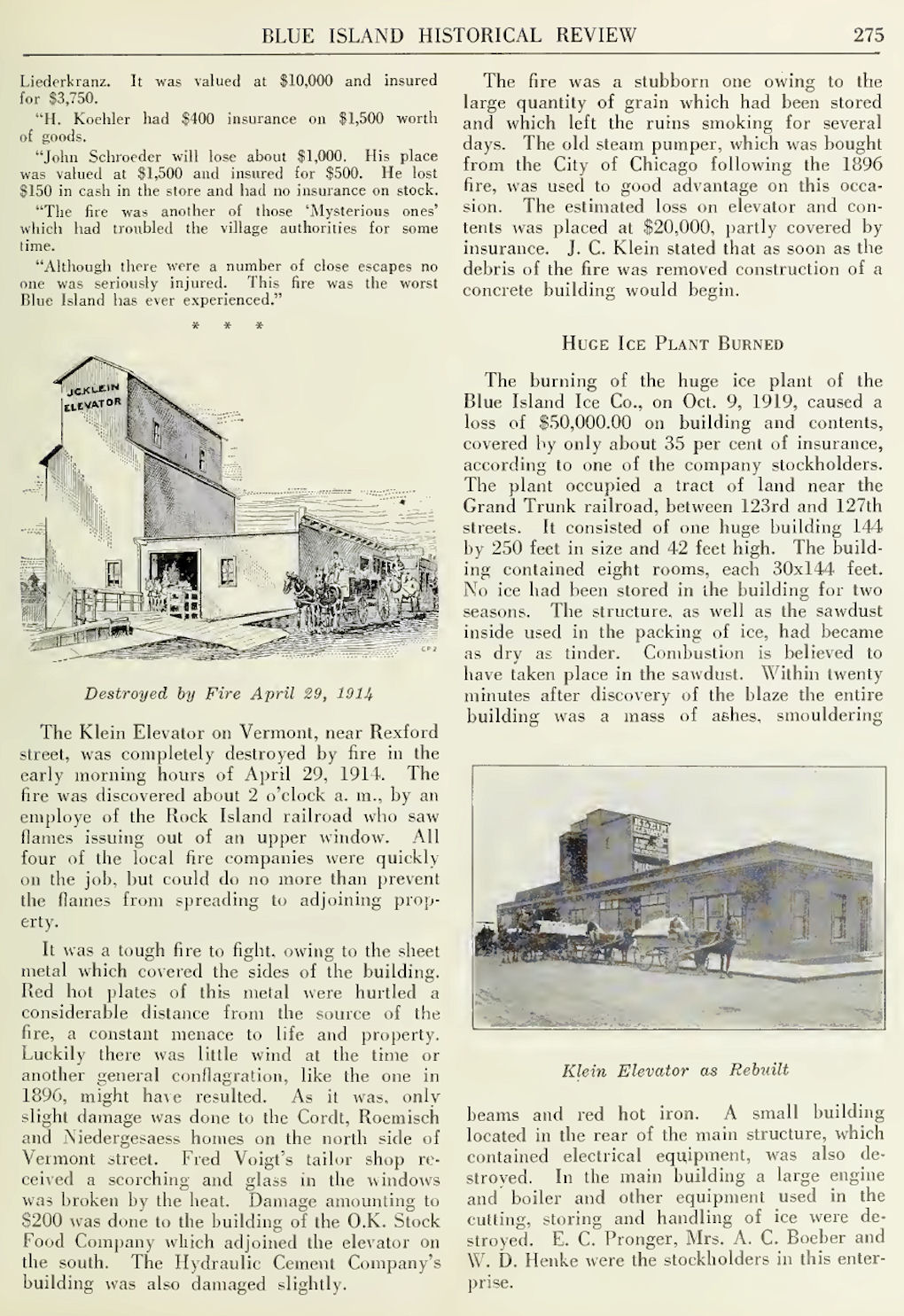
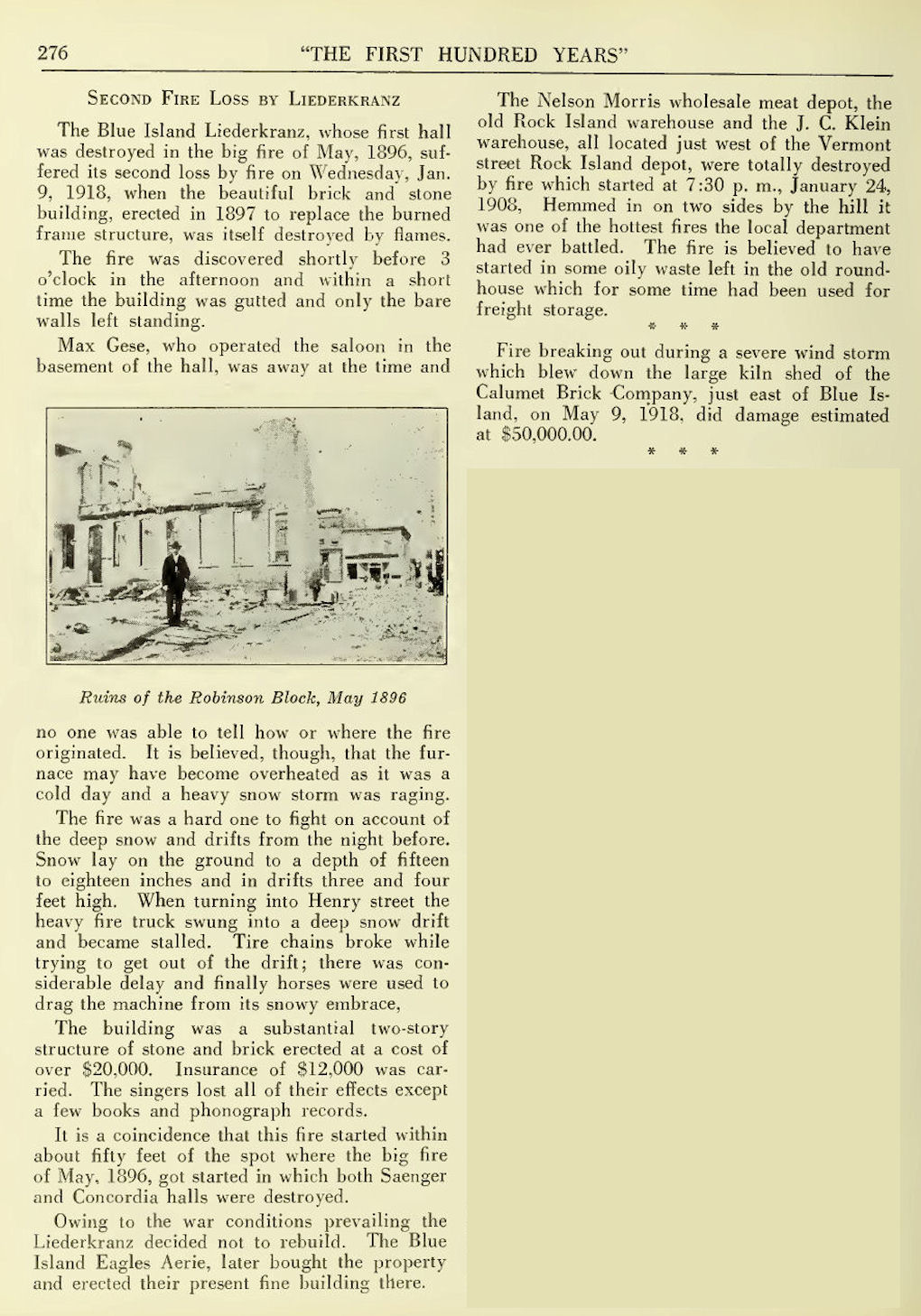
A total of forty-two business firms and twenty-nine houses were lost in the fire, which caused a loss estimated to be over $200,000.
See also: The Blue Island Library's History Museum: The Great Blue Island Fire of 1896
In the years following the Great Fire, Blue Island began the arduous task of updating and modernizing the Fire Department. In 1896 they bought their first horse-drawn steam fire pump from Chicago for $5 - it was resold for $175 in 1917 after they bought a shiny-new Seagrave Type "T" 800 Gallon Pump Engine. Blue Island also began enacting laws similar to Ordinance #277 of April 1894 that established fire limits along Western Avenue from Burr Oak to 135th Street outlawing the new construction of wood framed buildings.
More newspaper coverage: Here
And: Here
DEATH'S HARVEST. IT GOES RIGHT ALONG WITH AWFUL PERSISTENCE.
HORROR IN A CARTRIDGE FACTORY.
SOMEBODY EXPLODES A CAN OF POWDER AND THE RESULT IS ONE DEAD AND OTHERS FATALLY HURT -- SOME SIGHTS AT THE SCENE OF THE DISASTER.
Blue Island, Ill., Aug. 22. -- There was a terrific explosion in the Standard Cartridge factory yesterday afternoon in which three laborers were killed and thirteen others seriously wounded, three of whom will die. The explosion occurred in the packing room, but what caused it no one seems to know.
No one was about the packing room at the time of the accident, and those who were injured were working in the engineer's department. All the machinery in the factory was destroyed, and the windows of houses for blocks around the building were broken. The fatally injured were sent to Chicago on the Rock Island train to be conveyed to the county hospital. One of the injured is reported to have died on the way to the hospital.
The dead:
CHARLES F. SEIDELL, 25 years old, single, was killed.
The injured are as follows:
E. B. BURKE, face, hands, arms, and body burned.
FRANK LAWS, face, chest, and limbs burned.
GEORGE WELLS, face and hands burned.
ALEC LAMOR, face burned.
IDA WICKS, leg badly burned.
MARY SEPHEN, chin and nose mangled.
ANNIE McELBACH, side burned and hair scorched.
EMMA SCHOUP, arms burned.
LENA SCHOUP, face and hands burned.
LENA ROLL, face and arms burned.
EUGENE REINBERGER, face burned.
WILL DORMAN, face and hands badly burned.
JOE BASSETT, face blistered.
C. BREMEISTER, face blistered.
MARK BARNEY, face blistered.
When help came to the unfortunates girls were found lying half naked in the mud and grass, and crying for some one to relieve their sufferings. Stripped of their clothing, they were blistered and blackened and swollen till their most intimate friends scarcely knew them. Of the twelve girls employed in the factory only three escaped without injury. The remaining nine were removed to a farm house half a mile away, where they were given medical attention, and afterwards supplied with clothing and removed to their homes. The ages of the girls raged from 14 to 19 years.
IDA WICK, aside from the terrible burns she received, was crushed under a piece of iron that fell of of a machine. She was engaged in packing and labeling cartridges not far from the machine that exploded. MARK BARNEY, who was one of the most terribly burned, was feeding blank shells into the tube of the machine that exploded. He was blown up in the air by the explosion and fell in the fire. There he lay, unable to extricate himself from the twisted rods, until the smoke had partially blown away and he was helped out by his brother. His face, arms and body were almost cooked in places, and every particle of clothing he had on save his shoes and stockings was burned off. ALEXANDER LAMOR, whose injuries will probably cause his death, was working at a machine just next to the one that was blown up. Almost every portion of his body was burned, and he was gashed about the abdomen. His wounds were burned and blackened by the powder.
The proprietors of the factory say the disaster was caused by the gross carelessness of one of the men in opening a can of powder with a hammer and chisel.
Evening Gazette Sterling Illinois 1890-08-22
A TERRIBLE EXPLOSION
Six Men Instantly Killed and Thirteen Badly Injured Near Chicago.
There was a terrific explosion in the Standard cartridge factory at Blue Island, twelve miles out of Chicago, Ill. The building was torn to pieces, and window glass was broken for a half mile around. The explosion occurred in the packing house. There was nobody at work in this portion of the factory, but the concussion destroyed the engineer's room, where several men were employed.
CHARLES SEIDEL and five fellow laborers were killed outright and thirteen others were injured, four of whom will die. These are E. E. BURKE, LAZARUS KITTERHOUSE, JOHN SANDERS and MARTIN VAUDERHOUSE. The bodies of the dead were so badly mangled that identification was impossible.
When the Rock Island passenger train rolled into the Lake Shore station that night it had a car full of men who were bleeding from wounds. They were taken to the county hospital in three ambulances. The cause of explosion is not known.
The Cranbury Press New Jersey 1890-08-29
More: Info
More to come when I learn more - please share any information you have about this incident with me.
